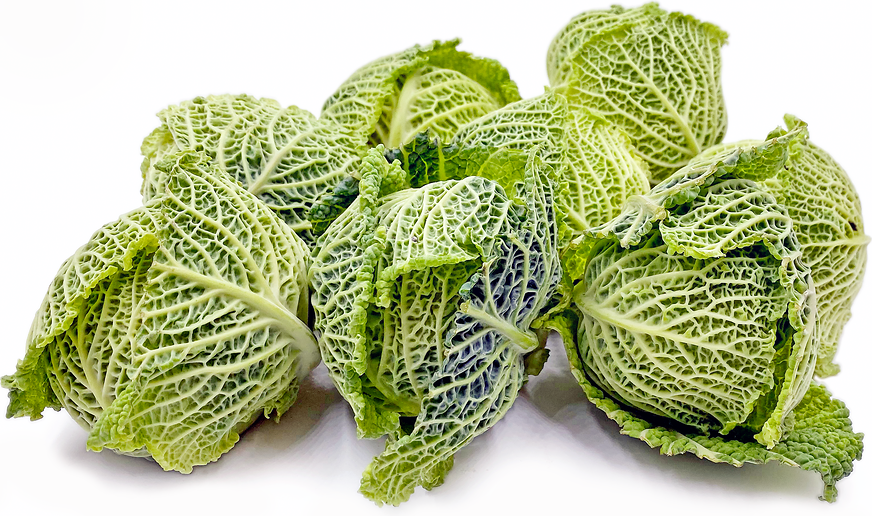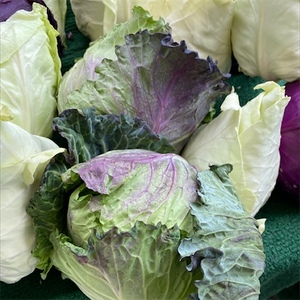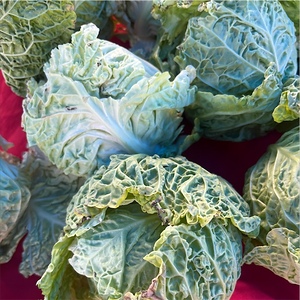


Baby Savoy Cabbage
Estimated Inventory, lb : 0
Description/Taste
Baby Savoy cabbages are small heads, averaging 10 to 15 centimeters in diameter, and consist of many layers of leaves forming a round to ovate shape with ruffled edges. The leaves are heavily textured with thick veining spanning across the surface and are crisp, crinkled, and firm. The heads also exhibit variegated pale to dark green hues on the exterior, and when sliced open, the interior leaves reveal even lighter, pale green to yellow tones. Baby Savoy cabbage has a tender, crunchy consistency and is known for its very mild, sweet, and musky flavor.
Seasons/Availability
Baby Savoy cabbages are available in the fall through mid-spring.
Current Facts
Baby Savoy cabbages, botanically classified as Brassica oleraca var. sabauda, are compact heads that belong to the Brassicaceae family. The textured cabbages are cultivated around the world for their small size and are favored for their sweet and mild flavor. There are multiple varieties of savoy cabbage that can be harvested young, approximately sixty-five days after sowing, and sold as Baby Savoy, and some growers also use specific cultivation methods to produce the miniature heads. Baby Savoy cabbages are valued by consumers for their novelty, crepe-like leaves, and versatility in both raw and cooked applications.
Nutritional Value
Baby Savoy cabbage is an excellent source of fiber which can help regulate digestion and is a good source of vitamins C and K, which can boost immunity within the body. The small heads also contain potassium, magnesium, calcium, manganese, and iron.
Applications
Baby Savoy cabbage is best suited for both raw and cooked applications such as boiling, roasting, and braising. The heads are favored for their small size and are often prepared whole or halved to showcase their miniature nature. Baby Savoy cabbage can be stuffed with grains, meats, and sauces as a main dish, halved and mixed into casseroles, roasted as a sweet and tender side, or boiled and coated in fresh sauces. The heads can also be sliced and tossed into curries, stews, and soups, shredded and stirred into coleslaw for additional texture and flavor, mixed into pasta, or chopped and added raw to salads. Baby Savoy cabbage pairs well with meats such as pancetta, pork chops, ground beef, and poultry, seafood, potatoes, tomatoes, garbanzo beans, mushrooms, leeks, peas, herbs such as dill, thyme, and sage, balsamic vinegar, and honey. The cabbages will keep 1-2 weeks when loosely wrapped in plastic and stored in the crisper drawer of the refrigerator.
Ethnic/Cultural Info
Baby vegetables were the symbol of nouvelle cuisine, which was a new style of cooking that emerged from France in the late 1960s. The term nouvelle has been used for multiple instances in French history to describe a new wave of cooking, but the most important historical use of the term was when the Le Nouveau Guide was published in 1969. The monthly magazine was written by French chefs and writers Christian Millau, Henry Gault, and Andre Gayot and featured new cooking styles focused on small plates, lighter sauces, and fresh, flavorful ingredients. Nouvelle cuisine was created during a time of French cooking that was using heavy sauces, high fat, and large plates, and chefs countered this style by creating more artistic dishes, focusing on presentation, where they could develop dishes with an aesthetic similar to the beauty found in paintings. With the nouvelle movement rapidly increasing in popularity, the rise of baby vegetables was also seen across commercial markets. Baby vegetables were often the star ingredient of nouvelle cuisine as their small size provided dishes with fresh flavors, unique visuals, textures, and colors, and an untraditional feel that promoted the chef’s perspective on food as a form of escapism from reality.
Geography/History
Savoy cabbage is believed to have originated in Europe and was first documented in the 1500s in an area once ruled by the Italian House of Savoy. This region bordered France, Italy, and Switzerland, and the cabbage was later introduced to northern Europe in the 18th century. While the exact origins of when Baby Savoy cabbage was commercially cultivated as a new item is unknown, baby vegetables became widely popular in European markets in the 20th century. The Baby Savoy cabbages featured in the photograph above were grown along the northern coast of Brittany in France by Prince de Bretagne, which is a produce brand that exports vegetables across Europe. Today Baby Savoy cabbage can be found through specialty grocers and local markets in Europe, Asia, South Africa, Canada, and the United States.
Recipe Ideas
Recipes that include Baby Savoy Cabbage. One
| Delicious Magazine |
|
Baby Savoy Cabbage with Pancetta and Star Anise |
| The Spruce Eats |
|
Butter-Braised Cabbage |









